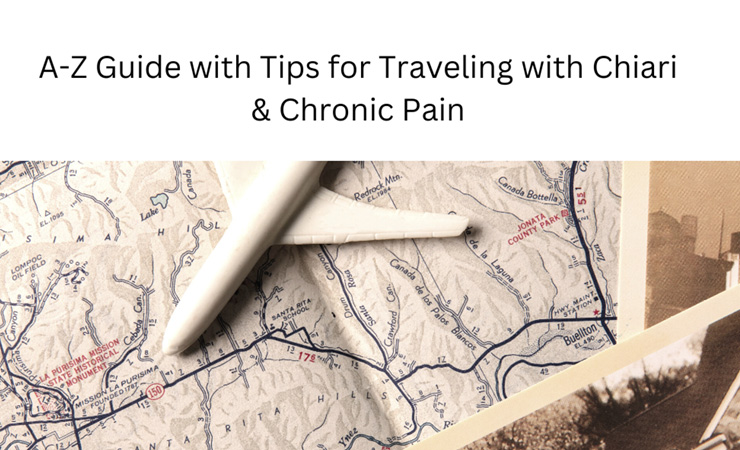A-Z Guide with Tips for Traveling with Chiari & Chronic Pain
Traveling can often be stressful without the added burden of chronic pain conditions. Thankfully, most patients with Chiari or syringomyelia report not having any additional pain issues When traveling by airplane. Following this guide will help you enjoy a safe and comfortable journey. Always check with your health care provider with any questions or concerns prior to traveling.
1. Arrive to the airport early, especially if you need to request assistance. Having extra time will allow you to take breaks or move around to keep up good circulation before boarding your flight. You can also take this time to inform the gate attendant that you may need assistance on the plane.
2. Book your flight early for the most choices for your comfort. Aisle seats, which are ideal for stretching and moving around the plane, are more likely to be available when booking a flight early.
3. Carry-on all “pain management must-haves.” Double check your packing list for the essentials, like medication, disposable heating/cooling pads, braces, pain creams, a neck pillow and any other comfort items. Bring gum for “popping ears” and a couple anti-inflammation snacks, especially if you have food sensitivities.
4. Documentation of your illness, along with your doctor’s name and phone number, can be helpful at TSA checkpoints or if you happen to need medical assistance. Providing a physician-signed medical letter detailing your chronic pain condition may help obtain special accommodations, like an upgraded seat, extra blankets or pillows or permission to move around when needed.
5. Emergency contact setup is available on smart phones. Add a trusted individual for emergency responders to call and add any medical concerns to your Medical ID on your phone. First responders can access this information without your phone’s password. Consider wearing a medical alert bracelet with this information so it’s always on your person.
6. Fill any prescriptions or pain medicine well in advance. Have enough for the duration of your trip plus several extra days’ supply in case of unforeseen delays.
7. Ground transportation may also be a part of your journey. Thankfully, there are increasing options for comfortable rides. App services like UberWAV, and Lyft AccessMode Pilot allow wheelchair access. If renting a specially equipped van is needed, services like Accessible Vans of America or Freedom Motors may be helpful.
8. Hydration is key to feeling your best and avoiding chronic pain. Bring a lightweight refillable water bottle to fill for free once you pass through security.
9. Insurance, like travel insurance protection can protect the investment of your trip. You can add it separately from a company of your choice or while booking your flight. An additional upfront fee will allow you to cancel the trip in the event of illness.
10. Just in case, you may want to consider a trusted friend by your side. It may be possible to get permission for a companion to accompany you through security and boarding. Contact the airline in advance to learn how.
11. Keep moving as much as possible. Long periods of time sitting can make back and neck pain worse. Try stick-on heating pads or a brief walk to get circulation moving. If you are in physical therapy, perform exercises from your home-care program (chin-tucks, anyone?).
12. Laws have been made to protect individuals’ rights while flying. The Air Carrier Access Act (ACAA) provides airlines with a rule of law outlining the rights of passengers of all flights traveling within, to or from the United States.
13. Medication is a top priority. If you have medications that need to be kept cold, bring a lunch box with freezer pack and make sure there’s a refrigerator in your hotel room to store them.
14. Neck support is critical for resting comfortably with chronic Chiari and syringomyelia neck pain. Don’t forget a supportive travel pillow and also a blanket. Airports and planes are notoriously cold.
15. Obtain precheck enrollment, beginning with an online application. TSA PreCheck or a Global Entry membership can help you speed through airport security screening. Check the Department of Homeland Security’s Trusted Traveler Tool for more information about preboarding and other services.
16. Preboard your flight. Airlines are required to offer pre-boarding and wheelchair or motorized escorts to passengers with disabilities who notify them. At the beginning of boarding, you will hear an announcement for any passengers needing assistance on the plane.
17. Research what assistance is available and if you qualify for medical assistance. The U.S. Department of Transportation provides a guide on Wheelchair and Guided Assistance. Contact the airline and airport 48-72 in advance to request accommodations. With advance notice, the airport can provide wheelchair access, luggage help, elevator access, tips getting through security and early boarding.
18. Ship luggage or heavy and bulky items to your destination. Check prices for local carriers or try services like Luggage Free, Send My Bag and Lugless that handle delivery directly to your hotel or other locations.
19. Traveling by train might be your most comfortable option. Not only do you have more space to sit, but you also can stand up and stretch during the ride. Amtrak even offers a 10% discount if you can provide documentation to support the need for accommodating a disability. People with disabilities may also receive a 50% cross country discount from Boston to Portland. Remember to research in advance because assistance at various stations may not always be available.
20. U.S. Department of Transportation provides a full list of services that airlines are required to provide individuals with disabilities on their website. Visit transportation.gov for more info.
21. VIP luxury makes all the difference. If it fits within budget, purchase as much comfort as possible. Business-class seats offer more legroom and better amenities than economy class. Some airports offer relaxation services from spas and massage stations to free yoga and meditation rooms. Check if your airline or credit cards offer perks that can get you into spacious airport lounges.
22. Wear comfortable clothes and pack a good pair of shoes for walking or standing, especially if you’re sightseeing. You may even want to bring a back-up pair, but pack as light as possible to avoid the stress of carrying unnecessary weight.
23. Expect the worst and be prepared (with more than that extra pair of shoes). You may even want to book an extra day or two for resting, especially if traveling a long distance.
24. You are not invisible. Airline personnel are trained to assist anyone who self-identifies as needing assistance services. You can obtain a sunflower lanyard from customer service to signify an invisible illness.
25. Zoom to your next destination with zero questions, but if a question should arise, try the TSA Cares helpline for individuals with disabilities, medical conditions or other special circumstances. TSA Cares provides details about screening policies and what to expect at security checkpoints. If you find yourself in need of special accommodations, ask a TSA agent for a “passenger support specialist” at the airport.

